How To Be Successful in Your Breeding Business - Chihuahua Caesareans
My Chihuahua has problems
giving birth.
Shall I call the vet?
asiahomes.com.
Written by: Toh
Wan-ting
Chinese translation: Toh
Wan-ting
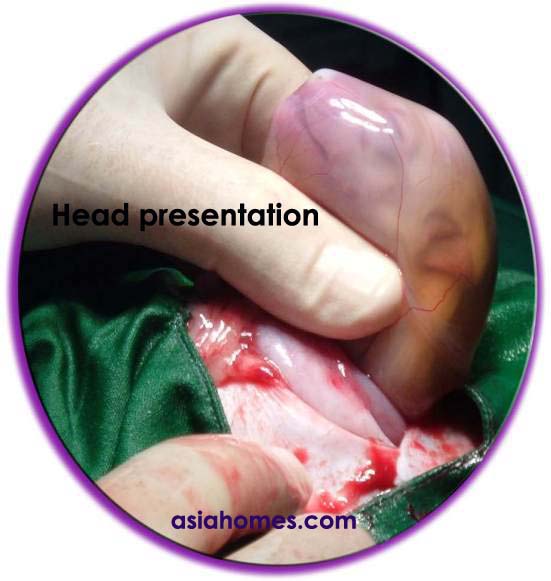 You
have beautiful Chihuahuas that you would like to breed.
Perhaps you
wish to sell puppies to the pet shop to supplement your income
as you may not be gainfully employed. Or you wish to become an
entrepreneur and start up a professional dog breeding farm later. You
have beautiful Chihuahuas that you would like to breed.
Perhaps you
wish to sell puppies to the pet shop to supplement your income
as you may not be gainfully employed. Or you wish to become an
entrepreneur and start up a professional dog breeding farm later.
But there is a big question in your mind. When your beloved dog is
in labour, what should you do? Let her give birth naturally? Try to help her? Or rush to the vet
immediately?
In this report, I shall answer the frequently asked questions and describe
a caesarean section I had encountered when I was attached to a veterinary
practice during my 2nd year at the junior college.
FREQUENTLY
ASKED QUESTIONS
1. My dog
has contractions for over an hour and yet she cannot give birth. What
should I do?
In this case,
you can wait up to two hours. After that, your vet should be consulted. The two-hour wait
ideally should be the time when your
dog just starts labour contractions to the time you arrive at the veterinary
surgery. Do not wait for two hours and then travel to the vet. It
may be too late to save the puppies or the dam. Phone your
vet early so that he or she has enough time to prepare for an emergency
caesarean. If you find that you don't need the caesarean, it is
courteous to inform your vet.
|
2.
I can see the puppy’s head or backside, but the body does not come
out, what to do now?
It may be too late to save the puppy by the time you reach the
veterinary surgery if you exceed the two hours. You may
attempt to pull the puppy out. The dam may bite you. Use
a towel to cover the dam's head. If the puppy is still
in the amniotic sac, break the sac and pull the puppy out. Go
to your if you experience difficulties.
3. I discover a smelly dirty-green colour vaginal discharge.
Go to the vet immediately to save the mother. The puppy
has died as the placenta has separated and is no longer
supplying blood and nutrients to the puppy.
4. Is a caesarean section needed for my heavily pregnant dog?
Smaller breeds with more than four puppies may have difficulty
giving birth. An X-ray or scan will let you know how many
puppies are present. It is wise to opt for an elective
caesarean to ensure you get the most number of vigorous
puppies. You may wish to elect for an emergency Caesarean when
you encounter any difficulty-in-giving-birth problems.
|
Be prepared to sacrifice one or more
puppies if you cannot make it in time to the veterinary surgery. It takes
time to travel or find a taxi and to anaesthesia the mother.
4.1 Elective caesarean section
This is a
planned caesarean. You inform your vet who will perform the
caesarean when it is time. How to know if it is time?
This caesarean can be carried out between 59 to 63 days after
the first mating. An alternative is when your dog experiences labour pain but you do not see any puppy coming out after 2
hours.
4.2 Emergency caesarean section
When your dog
has successfully given birth to the first or any puppy, but
the other puppy or puppies are not born after two hours.
Go to your vet immediately to increase the chances of
survival for the remaining puppies.
5. The
amniotic sac (water bag) is out but I do not see any puppies, what can I
do?
Rush to the vet within two hours of seeing the
amniotic sac.
|
THE CAESAREAN DELIVERY
I shall briefly bring you through the process of caesarean
section or delivery.
1. The dam's belly is shaved and
cleaned up to minimise the risk of bacterial infection. The dam is given a gas
anaesthetic.
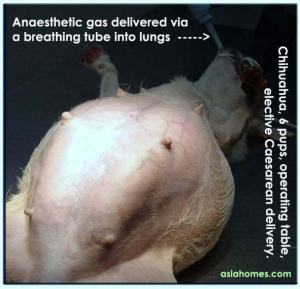
After she is unaware of pain, the vet incises
along the midline of the abdomen.
This incision
is approximately 2 inches (around 5 cm) which is about the size of the
puppy’s head. The first incision only cuts the skin.
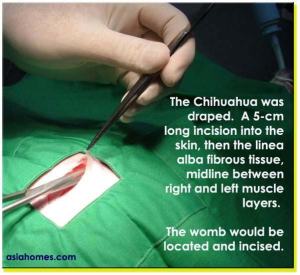
Then the fibrous
tissue connecting the right and left abdominal muscles is incised. The the womb
is located and carefully incised.
|
2. The first
puppy is pulled out. The amniotic membrane that encloses the
puppy is immediately removed. The umbilical cord is clamped an inch (2.5
cm) from the puppy's navel and cut. The puppy’s mouth and nostrils
are immediately wiped to remove mucus so that it can breathe naturally.
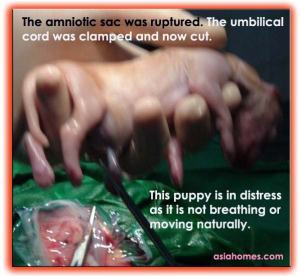 If the puppy is in distress, the vet
will immediately revive the puppy. If the puppy is in distress, the vet
will immediately revive the puppy.
The vet will hold the puppy’s
head with two hands. He swings the puppy's head down towards the floor to dislodge the mucus in the puppy’s lungs. This will enable the
puppy to breathe on his own.
If this does not work, the vet will then
attempt mouth-to-mouth aspiration.
In this method, the puppy's head is put
into the mouth of the vet. The vet uses his lips to suck out water
in the puppy’s lungs.
Another method is to blow air into the puppy's lungs to inflate the lungs.
In the Caesarean section, the first puppy emerged tail first. It had defecated inside the amniotic sac and
brownish yellow stools were seen. This meant
that the puppy was overdue. It was very weak and did not move
much.
A normal puppy opens its mouth and cries immediately on breaking
of the
amniotic sac during the Caesarean delivery. It wriggles as if trying
to escape from the surgeon's hands.
4. When all the puppies are taken out,
the vet will sew up the incisions.
The dam will be cleaned up. She is
injected with oxytocin which induces milk production. An antibiotic
injection is usually given. |
5. The
distressed puppies should be given extra care. Signs of distress
include a blue or purple nose. This is due to the lack of oxygen
in the blood. Chihuahuas are more sensitive to delays in
seeking Caesarean deliveries. Usually the first pup has died
by the time the inexperienced home breeder decides to seek
veterinary help.
The mouth-to-mouth aspiration, blowing air to inflate
the puppy's lungs and the swinging of the
puppy downwards can also be done by the home-breeder if he or she knows
how to do it. Many, including professional dog breeders are not
comfortable when asked to perform the vital mouth-to-mouth resuscitation
for the puppies. This brief report does not cover every problem you will encounter in
canine birth. You will need to learn the art of reviving the puppies from your vet or an
experienced dog breeder before you encounter problems. The
National Library in Singapore and book shops have magazines and books on dog breeding
for you to educate yourself.
In conclusion, I wish you success in your breeding.
Remember the two-hour rule and consult your vet when you are in
doubt.
|
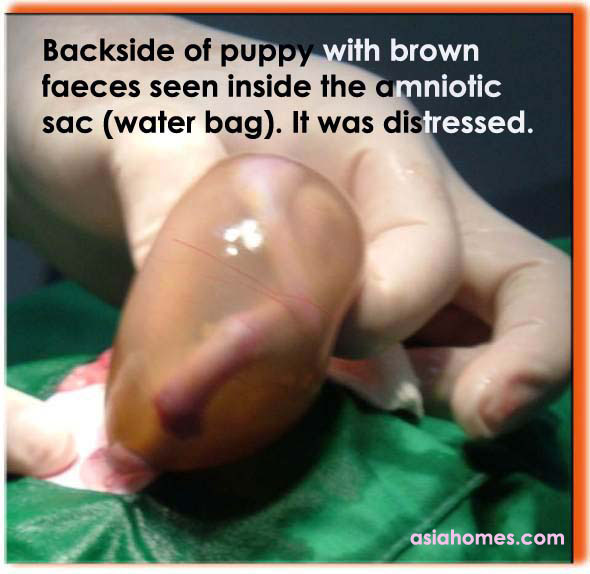 |
The passing of meconium
(brown puppy stools) inside the amniotic sac (PICTURE above) usually indicates that the
puppy is in distress. The picture shows that the puppy's
backside comes out first if it is born naturally. 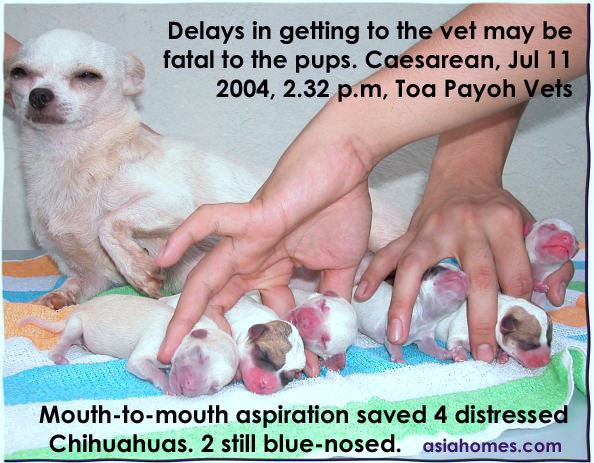
Delay
in finding transport to the vet. Four weak
puppies were delivered by Caesarean section.
The 2
blue-nosed puppies were lst and 4th puppies from the left, 10
minutes after the end of surgery. The dam looked distressed
too.
These puppies survived the crucial first 7 days as there was
an experienced full-time kennel assistant.
|
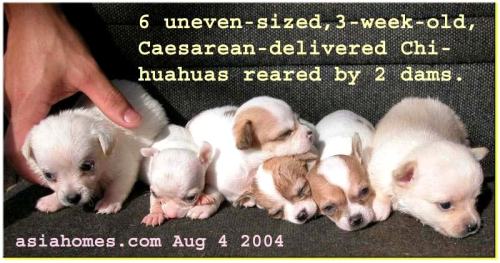 One
secret of success in dog breeding is that the
breeder must have other dams with milk in case the natural
mother has no milk or is unfit to nurse the puppies. One
secret of success in dog breeding is that the
breeder must have other dams with milk in case the natural
mother has no milk or is unfit to nurse the puppies.
If not, use stomach tubing, nursing bottles or a syringe to feed
the canned milk to the puppy every 2 hours for the first week.
The 6 Chihuahua puppies born by Caesarean delivery survived past six weeks.
They were of
different sizes. In Chihuahuas, the smaller size is
preferred by the Singaporean puppy buyers. |
|
|
